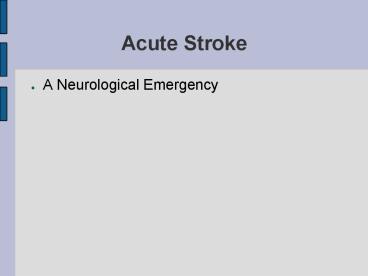Acute Stroke - PowerPoint PPT Presentation
1 / 51
Title:
Acute Stroke
Description:
Acute Stroke A Neurological Emergency Acute Stroke Show stroke is an emergency Discuss stroke subtypes Appropriate investigations Acute stroke Benefits of treatment ... – PowerPoint PPT presentation
Number of Views:55
Avg rating:3.0/5.0
Title: Acute Stroke
1
Acute Stroke
- A Neurological Emergency
2
Acute Stroke
- Show stroke is an emergency
- Discuss stroke subtypes
- Appropriate investigations
3
Acute stroke
- Benefits of treatment
- Acute therapy
- inpatient and outpatient
- Prevention
- primary and secondary
4
Acute Stroke
- Common
- Serious
- Preventable
- Treatable
5
Acute Stroke
- Medical Emergencies
- Rapid onset
- Poor prognosis
- Need for prompt treatment
6
Acute StrokeA Medical Emergency
- Comes on quickly
- Poor prognosis
- 12 mortality at 7 days
- 19 at 30 days
- 31 at one year
- Needs urgent treatment
- TIME BRAIN
7
Is it a Stroke?
- Focal Signs
- Negative symptoms
- Sudden onset
- Appropriate context
- Older age group
- Vascular risk factors
8
What kind of stroke?
- TACI
- PACI
- LACI
- POCI
9
OXFORDSHIRE COMMUNITY STROKE SUBCLASSIFICATION
SYSTEM
- TACI
- Large cortical stroke
- MCA /- ACA territories
- Higher cerebral dysfunction
- Dysphasia
- Acalculia
- Neglect
- AND
- Hemianopia
- And
- 2/3 of face/arm/leg
10
OXFORDSHIRE COMMUNITY STROKE SUBCLASSIFICATION
SYSTEM
- PACI
- 2 out of 3 of TACI
- OR
- motor/sensory deficit more restricted than LACI
- OR
- Higher centre dysfunction alone
11
OXFORDSHIRE COMMUNITY STROKE SUBCLASSIFICATION
SYSTEM
- LACI
- Pure motor stroke
- Pure sensory stroke
- Sensorimotor stroke
- Ataxic hemiparesis
- Dysarthria-clumsy hand syndrome
12
OXFORDSHIRE COMMUNITY STROKE SUBCLASSIFICATION
SYSTEM
- POCI
- Ipsilateral cranial nerve lesion with
contralateral motor/sensory deficit - Bilateral motor/sensory deficits
- Conjugate gaze palsy
- Pure cerebellar deficit
- Isolated homonymous visual field defect
13
Investigations
- Is it a stroke?
- Difficult in 1st 6 hours
- Type of stroke dictates investigations and their
urgency
14
Investigations
- CT
- Fast
- Reliable
- Available
- Differentiates between ICH and ischaemic stroke
- May show alternate diagnosis
15
Investigations
- CT
- When?
- As soon as practicable for most patients
- Haemorrhagic transformation and primary ICH can
be difficult to differentiate
16
Investigations
- ECG
- FBC
- Renal function
- BGL
- ESR or CRP
- Cholesterol
17
Investigations
- TACI
- Few needed
- LACI
- As above
- POCI
- As above
- PACI
- Carotid duplex
- Possibly TOE
18
Emergency Management
- Dr Christopher Trethewy
- Trelawney the unofficial Cornish anthem
19
Acute stroke treatment
20
(No Transcript)
21
(No Transcript)
22
(No Transcript)
23
(No Transcript)
24
(No Transcript)
25
(No Transcript)
26
(No Transcript)
27
(No Transcript)
28
(No Transcript)
29
(No Transcript)
30
(No Transcript)
31
(No Transcript)
32
(No Transcript)
33
(No Transcript)
34
(No Transcript)
35
(No Transcript)
36
(No Transcript)
37
(No Transcript)
38
(No Transcript)
39
(No Transcript)
40
(No Transcript)
41
(No Transcript)
42
(No Transcript)
43
Acute Stroke Treatment
- Does the patient qualify for thrombolytic
therapy? - Clearly defined time of onset
- Less than 3 hours
- No contraindications to thrombolysis
- Stroke not too mild nor too severe
- DIRECTLY TO ED, DO NOT PASS GO
44
Acute Stroke Treatment
- Recombinant tissue plasminogen activator
- Given within 3 hours
- To patients with appropriate stroke and CT
- REDUCES DEATH and DISABILITY at 3/12
- NNT 18
- NNH 34
45
Acute Stroke Treatment
- rTPA
- Expensive
- 5 of strokes
- High risk of harm if not ideal subjects
46
Acute Stroke Treatment
- Stroke Units
- Coordinated, goal directed rehabilitation
- Oxygenation
- Fever management
- Early mobilization
- BGL management
- PATHWAYS DON'T HELP
47
Acute Stroke Treatment
- Aspirin
- Started within 48 hours
- Reduces death, disability, recurrent stroke
- Improves recovery
- NNT 111
- NNH
- 2 ICH per 1 000
- 4 bleeds per 1 000
48
Acute Stroke Treatment
- BP reduction
- Possibly harmful early
- Neuroprotection
- No proven benefit to date
49
Prevention
- BP lowering
- Possibly ACE-I esp in diabetes
- Smoking cessation
- Lipid lowering (maybe)
- Anticoagulation for Afib if other risk factors
- Aspirin if other vascular disease
50
Secondary prevention
- Aspirin (and modified release dipyridamole)
- Anticoagulation if Afib
- CEA if symptomatic stenosis gt70
- BP lowering
- Smoking cessation
- Lipid lowering
51
Stroke an emergency
- Early hospitalisation if moderate stroke
- Aspirin within 48 hours if not for TPA
- Stroke Unit
- Aspirin plus vascular risk management































